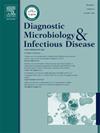大流行的蓝图:来自印度梅加拉亚邦SARS-CoV-2基因组学监测的见解
IF 2.1
4区 医学
Q3 INFECTIOUS DISEASES
Diagnostic microbiology and infectious disease
Pub Date : 2024-12-26
DOI:10.1016/j.diagmicrobio.2024.116670
引用次数: 0
摘要
2019冠状病毒病大流行暴露了医疗保健系统中的若干漏洞,暴露了全球的防备不足,并在全球范围内引发了前所未有的挑战,因此有必要转向缓解和强有力的监测战略。在这里,我们报告使用全基因组测序(WGS)检测印度梅加拉亚邦临床样本中的SARS-CoV-2变体,使用牛津纳米孔技术。从2021年8月至2023年5月在梅加拉亚邦各区收集的SARS-CoV-2阳性样本进行了WGS检测。在总共965个样本中,检测到Alpha (0.1%), Delta(47.2%)和Omicron(52.7%)变体。Delta变异影响53%的18岁以下的个体,而Omicron亚变异BA.2以类似的方式影响所有年龄组。该研究强调了使用用户友好的测序设备与简化的生物信息学相结合的有效性,使偏远地区能够有效地对抗Covid-19。这种方法具有快速、简单和准确的特点,有望应对未来的卫生危机。本文章由计算机程序翻译,如有差异,请以英文原文为准。
Blueprint of a pandemic: Insights from SARS-CoV-2 genomics surveillance in Meghalaya, India
The Covid-19 pandemic uncovered several lacunae in healthcare systems exposing global unpreparedness and triggering unprecedented challenges worldwide- necessitating a shift towards mitigation and robust surveillance strategies. Here, we report the use of Whole Genome Sequencing (WGS) to detect SARS-CoV-2 variants in clinical samples of Meghalaya, India, using Oxford Nanopore Technology. SARS-CoV-2 positive samples collected from various districts of Meghalaya from August 2021 to May 2023 were subjected to WGS. Out of a total of 965 samples, Alpha (0.1 %), Delta (47.2 %) and Omicron (52.7 %) variants were detected. The Delta variant affected 53 % of individuals under the age of 18 years, while the Omicron sub variant BA.2 affected all age groups in a similar manner. The study underscores the efficacy of using a user-friendly sequencing device coupled with simplified bioinformatics, enabling remote regions to effectively combat Covid-19. This approach, characterized by rapidity, simplicity and accuracy, holds promise in confronting future health crises.
求助全文
通过发布文献求助,成功后即可免费获取论文全文。
去求助
来源期刊
CiteScore
5.30
自引率
3.40%
发文量
149
审稿时长
56 days
期刊介绍:
Diagnostic Microbiology and Infectious Disease keeps you informed of the latest developments in clinical microbiology and the diagnosis and treatment of infectious diseases. Packed with rigorously peer-reviewed articles and studies in bacteriology, immunology, immunoserology, infectious diseases, mycology, parasitology, and virology, the journal examines new procedures, unusual cases, controversial issues, and important new literature. Diagnostic Microbiology and Infectious Disease distinguished independent editorial board, consisting of experts from many medical specialties, ensures you extensive and authoritative coverage.

 求助内容:
求助内容: 应助结果提醒方式:
应助结果提醒方式:


